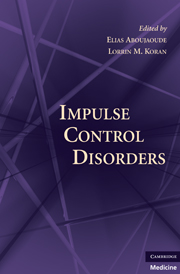Book contents
- Impulse Control Disorders
- Impulse Control Disorders
- Copyright page
- Dedication
- Contents
- Contributors
- Acknowledgments
- Introduction
- Section I Acquisitive Impulses
- Section II Pellicular Impulses
- 8 Trichotillomania: Clinical Aspects
- 9 Trichotillomania: The View from Dermatology
- 10 How to Create a National Advocacy Organization
- 11 Skin Picking: Clinical Aspects
- 12 SkinPicking: The View from Dermatology
- 13 Onychophagia (Nail Biting): Clinical Aspects
- 14 Nail Bitingand Other Oral Habits: A Dentist’s Perspective
- Section III Information-Seeking Impulses
- Section IV Sexual and Aggressive Impulses
- Appendix I: Treatment Guidelines
- Appendix II: List of Scales and Assessment Instruments
- Index
13 - Onychophagia (Nail Biting): Clinical Aspects
from Section II - Pellicular Impulses
Published online by Cambridge University Press: 06 July 2010
- Impulse Control Disorders
- Impulse Control Disorders
- Copyright page
- Dedication
- Contents
- Contributors
- Acknowledgments
- Introduction
- Section I Acquisitive Impulses
- Section II Pellicular Impulses
- 8 Trichotillomania: Clinical Aspects
- 9 Trichotillomania: The View from Dermatology
- 10 How to Create a National Advocacy Organization
- 11 Skin Picking: Clinical Aspects
- 12 SkinPicking: The View from Dermatology
- 13 Onychophagia (Nail Biting): Clinical Aspects
- 14 Nail Bitingand Other Oral Habits: A Dentist’s Perspective
- Section III Information-Seeking Impulses
- Section IV Sexual and Aggressive Impulses
- Appendix I: Treatment Guidelines
- Appendix II: List of Scales and Assessment Instruments
- Index
Summary
Keywords
- Type
- Chapter
- Information
- Impulse Control Disorders , pp. 144 - 156Publisher: Cambridge University PressPrint publication year: 2010
- 1
- Cited by

